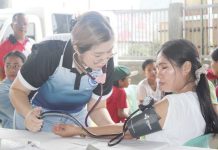BY ETHAN CHUA
ON JANUARY 12 of this year, Taal Volcano in the Philippines was placed on alert level 4 by the Philippine Institute of Volcanology and Seismology (Phivolcs), meaning a hazardous eruption could happen within hours to days.
As a result, nearly 380,000 individuals were affected by the risk of imminent eruption, with about 300,000 of them displaced, moving to nearby evacuation centers or outside shelters.
At least 752 hectares of land, comprising mostly coffee farms, were damaged by falling ash, with at least P74 million worth of agriculture destroyed. In the wake of the eruption, several hundred earthquakes followed, with homes being lost and livelihoods being displaced by the aftershocks.
On Aug. 8, 2019, human rights volunteer and environmental activist Brandon Lee was shot four times outside his home in the northern Philippines, where he’d been working as a journalist for the indigenous issues-focused newspaper Northern Dispatch. Brandon was also part of the Ifugao Peasant Movement (IPM), a collective focused on organizing communities in the area against land-grabbing by corporations intent on developing mines and dams on indigenous land. Marked an “enemy of the state,” Brandon was targeted by state security forces as part of the Philippine government’s sustained campaign against environmental activists.
Prior to the incident, army officials had investigated him and other IPM members with reference to President Rodrigo Duterte’s Executive Order 70, which justified a “whole of nation approach” to ending the ongoing communist insurgency.
Environmental defenders are often “red-tagged” by the state as communist sympathizers as retroactive justification for their killing. As a result, the Philippines has been called the country most dangerous in the world for environmental defenders by Global Witness, with 225 of them killed between 2001 and 2018.
These two disasters seem disparately connected, if at all – the former natural, the latter man-made; the former having to do with a suddenly active volcano, the latter having to do with a militarized state.
But in the Philippines, the links between environmental degradation and militarization are intimate. Government counterinsurgency campaigns have been most violent in the regions of the Philippines with natural and mineral resources that are largely untapped by extractive projects, whether it’s Mindanao in the south or the Cordilleras in the north.
Brandon was shot because he opposed a hydropower project that would have displaced indigenous communities in the north, while to the south, indigenous Lumad leaders have been killed and schools dedicated to the teaching of sustainable agricultural practices occupied under the guise of anti-communism.
The Philippine government systematically manipulates the free, prior and informed consent process meant to involve indigenous communities in decisions regarding the usage of their land in order to allow big energy projects sponsored by foreign and local corporations.
So what does this have to do with Taal? It’s worth remembering that no disaster is solely “natural.” A disaster, by definition, involves a human impact; this is why an earthquake in the middle of the Pacific Ocean wouldn’t make its way onto any newspaper.
In the case of Taal, disaster exists at the conjunction of natural force and human consequence, with the evacuation of communities, the loss of homes, and the lack of preparedness all coming together in catastrophic fashion.
The severity of disaster thus lies not only in the amount of ashfall, or in the magnitude of aftershocks, but also in the hamstrung political response – under the Duterte administration, the Philippines’ calamity fund has been cut by nearly 60 percent from 2016’s P39 billion fund to P16 billion. In comparison, the state continues to dedicate further expenses to its counterinsurgency operations, with P8.2 billion allocated to the Office of the President, of which P4.5 billion would go to “confidential and intelligence funds.”
This lack of institutional support for affected communities has manifested in displays of state incompetence, if not outright callousness, with the Department of Interior and Local Government (DILG) tweeting asking for donations from the public. (To be continued)
***
Chua is a member of the International Migrants Alliance USA Chapter and the Malaya Movement to end Human Rights Violations in the Philippines. (Bulatlat)





